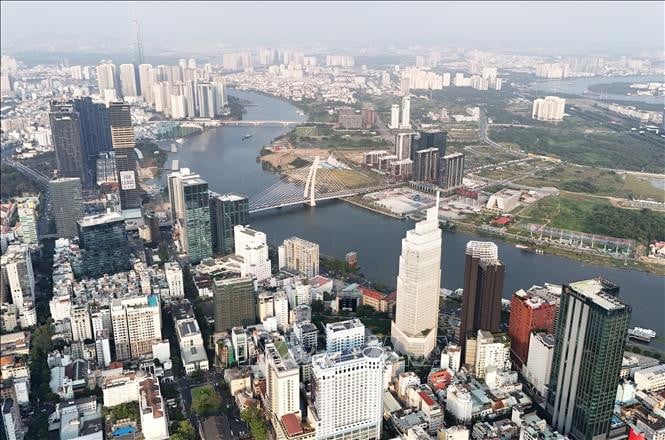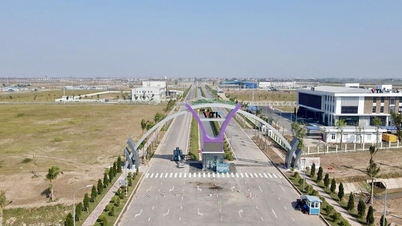The number of commune-level administrative units that have not met the standard orientation on natural area or population size is 154 (formed from the arrangement and merging of 2 commune-level administrative units, accounting for 4.82%), but cannot be arranged with adjacent commune-level administrative units.

The Ministry of Home Affairs said that after reviewing 10,035 current commune-level administrative units nationwide (7,694 communes, 1,724 wards, 617 towns), 63 provinces and cities determined that the number of commune-level administrative units to be reorganized was 9,907 (7,570 communes, 1,720 wards and 617 towns). There are 128 commune-level administrative units (124 communes and 4 wards) that will not be reorganized (remain the same) because they have met both standards on natural area and population size or have special factors (isolated location) according to the provisions of Resolution No. 76/2025/UBTVQH15.
Plan for arranging commune-level administrative units
According to the Proposal on the arrangement of commune-level administrative units in 2025, which was recently signed by Minister of Home Affairs Pham Thi Thanh Tra and sent to the Government, provinces and cities have developed 3,193 plans to arrange 9,907 commune-level administrative units to form 3,193 new commune-level administrative units, reducing 6,714 units.
Specifically:
Hanoi City has developed 126 plans to reorganize 526 commune-level administrative units (345 communes, 160 wards, 21 towns) to form 126 new commune-level administrative units (75 communes, 51 wards), reducing 400 units. Of these, 26 plans are to merge 3 or more commune-level administrative units; 100 plans are to adjust and reorganize 2 or more commune-level administrative units into 1 new commune-level administrative unit.
Ho Chi Minh City (new): The People's Committees of Ba Ria - Vung Tau, Binh Duong and Ho Chi Minh City have developed 163 plans to arrange 436 units (127 communes, 292 wards, 17 towns) to form 163 new commune-level administrative units (112 wards, 50 communes and 1 special zone), reducing 273 units.
Hai Phong City (new): The People's Committee of Hai Phong City and Hai Duong Province developed a total of 114 plans to arrange 374 units (232 communes, 125 wards, 17 towns) to form 114 new commune-level administrative units (67 communes, 45 wards and 2 special zones), reducing 260 units.
Hue City has developed 39 plans to rearrange 132 units (78 communes, 47 wards, 7 towns) to form 39 new commune-level administrative units (19 communes, 20 wards), reducing 93 units.
Da Nang City (new): The People's Committee of Da Nang City and Quang Nam Province developed a total of 92 plans to arrange 278 units (65 wards, 199 communes, 14 towns) to form 92 commune-level administrative units (23 wards, 68 communes, 1 special zone), reducing 186 units.
Can Tho City (new): The People's Committee of Can Tho City and Hau Giang and Soc Trang provinces developed a total of 95 plans to arrange 255 units (160 communes, 67 wards, 28 towns) to form 95 new commune-level administrative units (65 communes, 30 wards), reducing 160 units.
Lai Chau province has developed 36 plans to rearrange 104 units (92 communes, 5 wards, 7 towns) to form 36 new commune-level administrative units (34 communes, 2 wards), reducing 68 units.
Dien Bien province has developed 45 plans to rearrange 129 units (115 communes, 9 wards, 5 towns) to form 45 new commune-level administrative units (42 communes, 3 wards), reducing 84 units.
Son La province has developed 68 plans to rearrange 193 units (170 communes, 15 wards, 8 towns) to form 68 new commune-level administrative units (60 communes, 8 wards), reducing 125 units.
Lang Son province has developed 65 plans to rearrange 194 units (175 communes, 5 wards, 14 towns) to form 65 new commune-level administrative units (61 communes, 4 wards), reducing 129 units.
Quang Ninh province has developed 53 plans to reorganize 170 units (90 communes, 73 wards, 7 towns) to form 53 new commune-level administrative units (30 wards, 21 communes and 2 special zones), reducing 117 units.
Thanh Hoa province has developed 145 plans to arrange 526 units (63 wards, 32 towns, 431 communes) to form 145 new commune-level administrative units (126 communes, 19 wards), reducing 381 units.
Nghe An province has developed 121 plans to arrange 403 units to form 121 commune-level administrative units (110 communes, 11 wards), reducing 282 units.
Ha Tinh province has developed 67 plans to rearrange 207 units (168 communes, 25 wards, 14 towns) to form 67 new commune-level administrative units (58 communes, 9 wards), reducing 140 units.
Cao Bang province has developed 56 plans to rearrange 161 units (139 communes, 8 wards, 14 towns) to form 56 new commune-level administrative units (53 communes, 3 wards), reducing 105 units.
Tuyen Quang Province (new): The People's Committees of Tuyen Quang and Ha Giang provinces developed a total of 111 plans to arrange 317 units (283 communes, 15 wards and 19 towns) to form 111 new commune-level administrative units (7 wards, 104 communes), reducing 206 units.
Lao Cai Province (new): The People's Committees of Lao Cai and Yen Bai provinces have developed a total of 91 plans to arrange 311 units (264 communes, 28 wards, 19 towns) to form 91 new commune-level administrative units (10 wards, 81 communes) in the new Lao Cai province, reducing 220 units.
Thai Nguyen Province (new): The People's Committees of Thai Nguyen and Bac Kan provinces developed a total of 90 plans to arrange 278 units (214 communes, 47 wards and 17 towns) to form 90 new commune-level administrative units (75 communes, 15 wards), reducing 188 commune-level administrative units.
Phu Tho Province (new): The People's Committees of Phu Tho, Vinh Phuc, and Hoa Binh provinces developed a total of 146 plans to rearrange 477 units (395 communes, 42 wards, and 40 towns) to form 146 new commune-level administrative units (131 communes and 15 wards), reducing 331 units.
Bac Ninh Province (new): The People's Committees of Bac Ninh and Bac Giang provinces developed a total of 98 plans to arrange 312 commune-level administrative units (208 communes, 85 wards and 19 towns) to form 98 commune-level administrative units (33 wards, 65 communes), reducing 214 units.
Hung Yen Province (new): The People's Committees of Hung Yen and Thai Binh provinces developed a total of 104 plans to arrange 381 units (341 communes, 23 wards and 17 towns) to form 104 new commune-level administrative units (93 communes, 11 wards), reducing 277 units.
Ninh Binh Province (new): The People's Committees of Ha Nam, Nam Dinh, and Ninh Binh provinces developed a total of 129 plans to arrange 398 units (312 communes, 61 wards, and 25 towns) to form 129 new commune-level administrative units (97 communes and 32 wards), reducing 269 units.
Quang Tri Province (new): The People's Committees of Quang Binh and Quang Tri provinces developed 77 plans to arrange 263 units (216 communes, 28 wards, 19 towns) to form 77 new commune-level administrative units (68 communes, 8 wards, 1 special zone), reducing 186 units.
Quang Ngai Province (new): The People's Committees of Quang Ngai and Kon Tum provinces developed a total of 91 plans to arrange 267 units (224 communes, 27 wards and 16 towns) to form 91 new commune-level administrative units (81 communes, 9 wards and 1 special zone), reducing 176 units.
Gia Lai Province (new): The People's Committees of Binh Dinh and Gia Lai provinces developed a total of 126 plans to arrange 364 units (286 communes, 52 wards, 26 towns) to form 126 new commune-level administrative units (101 communes, 25 wards), reducing 238 units.
Khanh Hoa Province (new): The People's Committees of Khanh Hoa and Ninh Thuan provinces developed a total of 65 plans to arrange 194 units (143 communes, 42 wards, 9 towns) to form 65 new commune-level administrative units (48 communes, 16 wards, 1 special zone), reducing 129 units.
Lam Dong Province (new): The People's Committees of Lam Dong, Dak Nong and Binh Thuan provinces developed a total of 120 plans to arrange 325 units (255 communes, 40 wards, 30 towns) to form 120 new commune-level administrative units (103 communes, 20 wards, 1 special zone), reducing 205 commune-level administrative units.
Dak Lak Province (new): The People's Committees of Dak Lak and Phu Yen provinces have developed a total of 95 plans to arrange 279 units (224 communes, 36 wards and 19 towns) to form 95 new commune-level administrative units (81 communes, 14 wards), reducing 184 units.
Dong Nai Province (new): The People's Committees of Dong Nai and Binh Phuoc provinces developed a total of 88 plans to arrange 263 units (198 communes, 51 wards and 14 towns) to form 88 new commune-level administrative units (21 wards, 67 communes), reducing 175 units.
Tay Ninh Province (new): The People's Committees of Long An and Tay Ninh provinces developed a total of 96 plans to arrange 280 units (231 communes, 28 wards, 21 towns) to form 96 new commune-level administrative units (82 communes, 14 wards), reducing 184 units.
Vinh Long Province (new): The People's Committees of Ben Tre, Tra Vinh and Vinh Long provinces developed a total of 120 plans to arrange 350 units (296 communes, 28 wards, 26 towns) to form 120 new commune-level administrative units (101 communes, 19 wards), reducing 230 commune-level administrative units.
Dong Thap Province (new): The People's Committees of Tien Giang and Dong Thap provinces developed a total of 102 plans to arrange 305 units (249 communes, 39 wards and 17 towns) to form 102 new commune-level administrative units (82 communes and 20 wards), reducing 203 commune-level administrative units.
Ca Mau Province (new): The People's Committees of Ca Mau and Bac Lieu provinces developed a total of 63 plans to arrange 163 units (130 communes, 19 wards, 14 towns) to form 63 new commune-level administrative units, reducing 100 units.
An Giang Province (new): The People's Committees of An Giang and Kien Giang provinces developed a total of 96 plans to arrange 292 units (220 communes, 44 wards, 28 towns) to form 96 commune-level administrative units (79 communes, 14 wards, 3 special zones), reducing 196 commune-level administrative units.
154 commune-level administrative units have not met the standard orientation on natural area or population size.
According to the Ministry of Home Affairs, after the 2025 arrangement of commune-level administrative units of 34 provincial-level administrative units (after arrangement and merger of provincial-level administrative units), the country will have 3,321 commune-level administrative units, including 2,636 communes, 672 wards and 13 special zones. Of which, 3,193 commune-level administrative units were newly formed due to arrangement, merger and adjustment of commune-level administrative units and 128 administrative units were not arranged (remained the same). Thus, the total number of commune-level administrative units decreased by 6,714 compared to before the arrangement (a reduction rate of 66.91%).
The Ministry of Home Affairs said that 3,039/3,193 commune-level administrative units after the rearrangement ensured the regulations on natural area and population size standards in Resolution No. 76/2025/UBTVQH15 of the National Assembly Standing Committee (reaching a rate of 95.18%). Of which, 2,536/3,193 commune-level administrative units after the rearrangement (accounting for 79.43%) met both standards on natural area and population size according to the orientation prescribed in Clause 1, Article 5 of Resolution No. 76/2025/UBTVQH15.
There are 503/3,193 units (accounting for 15.75%) formed from the arrangement and integration of 3 or more commune-level administrative units that do not need to be considered for standard assessment and are subject to the provisions of Clause 2, Article 5 of Resolution No. 76/2025AJBTVQH15.
The number of commune-level administrative units that have not met the standard orientation on natural area or population size is 154 (formed from the arrangement and merging of 2 commune-level administrative units, accounting for 4.82%), but cannot be arranged with adjacent commune-level administrative units.
Source: https://baohungyen.vn/nhieu-xa-sau-sap-xep-chua-dat-tieu-chuan-ve-dien-tich-tu-nhien-hoac-quy-mo-dan-so-3181092.html



![[Photo] Prime Minister Pham Minh Chinh works with the Standing Committee of Thai Binh Provincial Party Committee](https://vphoto.vietnam.vn/thumb/1200x675/vietnam/resource/IMAGE/2025/5/12/f514ab990c544e05a446f77bba59c7d1)


![[Photo] Buddha's Birthday 2025: Honoring the message of love, wisdom, and tolerance](https://vphoto.vietnam.vn/thumb/1200x675/vietnam/resource/IMAGE/2025/5/12/8cd2a70beb264374b41fc5d36add6c3d)
![[Photo] Prime Minister Pham Minh Chinh starts construction of vital highway through Thai Binh and Nam Dinh](https://vphoto.vietnam.vn/thumb/1200x675/vietnam/resource/IMAGE/2025/5/12/52d98584ccea4c8dbf7c7f7484433af5)




















































































Comment (0)